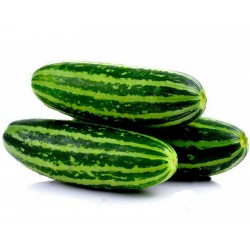Menu
-
MenuBack
- Home
-
Categories
-
-
Categories
-
Vegetable Seeds
-
Varieties by Country
- Varieties from Armenia
- Varieties from BiH
- Varieties from Croatia
- Varieties from France
- Varieties from Germany
- Varieties from Greece
- Varieties from Hungary
- Varieties from India
- Varieties from Italy
- Varieties from Japan
- Varieties from North Macedonia
- Varieties from Peru
- Varieties from Russia
- Varieties from Serbia
- Varieties from Slovenia
- Varieties from Spain
- Varieties from Thailand
- Varieties from Turkey
- Varieties from USA
- Tomato Seeds
- Corn Seeds
- Gourd family
- Bean family
- Cucumber Seeds
- Pepper Seeds
- Carrot family
- Onion family
- Lettuce Seeds
- Potato family
- Cabbage family
- Radish Seeds
- Beetroot family
- Watermelon Seeds
- Melon Seeds
- Cauliflower Seeds
- Sunflower family
-
Varieties by Country
- Fruit Seeds
- Chili - Habanero Seeds
- Medicinal Herb Seeds
- Climbing Plants Seeds
- Trees Bonsai Seeds
- Palm Seeds
- Ornamental Grasses Seeds
- Tobacco Seeds
-
Vegetable Seeds
-
-
-
-
- NEW PRODUCTS
- Create account
- Delivery - Payment
- FAQ
Last Product Reviews
These peppers came all the way from eastern Europe and took a while at no f...
By
 Fitim Berani on 21/09/2023
Fitim Berani on 21/09/2023
Verified Purchase
Last customers
- Tanja, Beograd, Serbia
- Alaa, Alwajh, Saudi Arabia
- ionescu, valu lui traian, Romania
- Lasse, 2900, Norway
- Pete, Cleves, United States
- Stef, Waalwijk, Netherlands
- Sonia, Minervino di Lecce, Italy
- Adrian, Ingolstadt, Germany
- CORINNE, NOTRE DAME DE LONDRES, France
- Dušan, KRAVANY NAD DUNAJOM, Slovakia
- Arno, Ehrenkirchen, Germany
- Costas, LARNACA , Cyprus
- Fulvio francesco, Santa Domenica Talao, Italy
- william, Dun, France
- Aymeric , Saint tricat, France
- Ricard, Sant Celoni, Spain
- Maureen , Enniscorthy Co Wexford , Ireland
- Paul, St. Vigil in Enneberg (BZ), Italy
- Ricardo jorge , Viseu , Portugal
- Radosav, Kragujevac, Serbia
- Sylvie, Neyruz, Switzerland
- Julien, Scionzier, France
- Zoran, Vinca, Serbia
- Josef, Hochdorf-Assenheim, Germany
- Davide, London, United Kingdom
- Kimberly, Victoria, Gozo, Malta
- Saša , Beograd, Serbia
- Ewa, Galway, Ireland
- Ioannis , Kato Achaia, Greece
- Samuele, Milano, Italy
There are 383 products.
Showing 37-48 of 383 item(s)

Best seller product
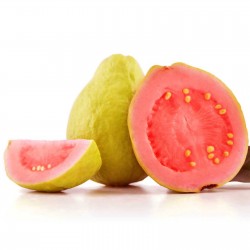
Common guava Seeds (Psidium...
Price
€2.15
SKU: V 38
Seeds Gallery Com,
5/
5
<h2><strong>Common guava, Yellow guava, Lemon guava Seeds (Psidium guajava)</strong></h2>
<h2><strong><span style="color: #ff0000;">Price for Package of 5 or 10 seeds.</span></strong></h2>
<p>Widely planted and naturalized in its native tropical America and in many other warm regions of the world, this tender evergreen shrub or small tree is prized for its delicious yellow-skinned, pink- or yellow-fleshed fruits, which are wonderful fresh and in preserves and juices. Ripening from fall into winter, the fragrant, round to pear-shaped, apple-sized, seedy fruits are preceded in early summer by mildly fragrant white flowers that have a boss of central stamens. Plants are self-fruitful, requiring no companion plants for fruit set. Attractive ribbed elliptic leaves are copper-tinged upon emergence. The flaking copper-colored bark adds further all-season interest.</p>
<p>This warmth-loving plant prefers ample sun and well-drained acidic to alkaline soil. It needs warm but not overly hot summers – give it partial shade if necessary to protect it from excessive heat. Use it in tropical gardens or in a warm humid greenhouse. It is considered a noxious exotic weed in Hawaii and other areas. (SOURCE: learn2grow.com)</p>
<p>The guava seems indiscriminate as to soil, doing equally well on heavy clay, marl, light sand, gravel bars near streams, or on limestone; and tolerating a pH range from 4.5 to 9.4. It is somewhat salt-resistant. Good drainage is recommended but guavas are seen growing spontaneously on land with a high water table–too wet for most other fruit trees.</p>
<table border="1" cellspacing="0" cellpadding="0">
<tbody>
<tr>
<td colspan="2" valign="top" width="100%">
<p><span style="color: #008000;"><strong>Sowing Instructions</strong></span></p>
</td>
</tr>
<tr>
<td valign="top" nowrap="nowrap">
<p><span style="color: #008000;"><strong>Propagation:</strong></span></p>
</td>
<td valign="top">
<p><span style="color: #008000;">Seeds</span></p>
</td>
</tr>
<tr>
<td valign="top" nowrap="nowrap">
<p><span style="color: #008000;"><strong>Pretreat:</strong></span></p>
</td>
<td valign="top">
<p><span style="color: #008000;">soak in water for 24 hours</span></p>
</td>
</tr>
<tr>
<td valign="top" nowrap="nowrap">
<p><span style="color: #008000;"><strong>Stratification:</strong></span></p>
</td>
<td valign="top">
<p><span style="color: #008000;">0</span></p>
</td>
</tr>
<tr>
<td valign="top" nowrap="nowrap">
<p><span style="color: #008000;"><strong>Sowing Time:</strong></span></p>
</td>
<td valign="top">
<p><span style="color: #008000;">all year round</span></p>
</td>
</tr>
<tr>
<td valign="top" nowrap="nowrap">
<p><span style="color: #008000;"><strong>Sowing Depth:</strong></span></p>
</td>
<td valign="top">
<p><span style="color: #008000;">0.5 cm</span></p>
</td>
</tr>
<tr>
<td valign="top" nowrap="nowrap">
<p><span style="color: #008000;"><strong>Sowing Mix:</strong></span></p>
</td>
<td valign="top">
<p><span style="color: #008000;">Coir or sowing mix + sand or perlite</span></p>
</td>
</tr>
<tr>
<td valign="top" nowrap="nowrap">
<p><span style="color: #008000;"><strong>Germination temperature:</strong></span></p>
</td>
<td valign="top">
<p><span style="color: #008000;">25 ° C +</span></p>
</td>
</tr>
<tr>
<td valign="top" nowrap="nowrap">
<p><span style="color: #008000;"><strong>Location:</strong></span></p>
</td>
<td valign="top">
<p><span style="color: #008000;">bright + keep constantly moist not wet</span></p>
</td>
</tr>
<tr>
<td valign="top" nowrap="nowrap">
<p><span style="color: #008000;"><strong>Germination Time:</strong></span></p>
</td>
<td valign="top">
<p><span style="color: #008000;">1-3 months</span></p>
</td>
</tr>
<tr>
<td valign="top" nowrap="nowrap">
<p><span style="color: #008000;"><strong>Watering:</strong></span></p>
</td>
<td valign="top">
<p><span style="color: #008000;">Water regularly during the growing season</span></p>
</td>
</tr>
<tr>
<td valign="top" nowrap="nowrap">
<p><span style="color: #008000;"><strong> </strong></span></p>
</td>
<td valign="top">
<p><br><span style="color: #008000;"><em>Copyright © 2012 Seeds Gallery - Saatgut Galerie - Galerija semena. </em><em>All Rights Reserved.</em><em></em></span></p>
<p><span style="color: #008000;"><em> </em></span></p>
</td>
</tr>
</tbody>
</table><script src="//cdn.public.n1ed.com/G3OMDFLT/widgets.js"></script>
V 38 (5 S)

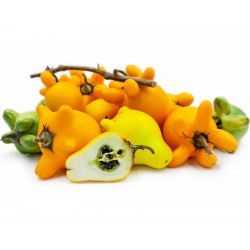
Nipplefruit Seeds - Cow's...
Price
€2.25
SKU: V 39
Seeds Gallery Com,
5/
5
<h2><strong>Nipplefruit Seeds - Cow's udder (Solanum mammosum)</strong></h2>
<h2><span style="color:#ff0000;"><strong>Price for Package of 10 seeds.</strong></span></h2>
<p><em><strong>Solanum mammosum</strong></em> is commonly known as <strong>nipplefruit</strong>,<sup>[1]</sup> <strong>fox head</strong>,<sup>[2]</sup> <strong>cow's udder</strong>, or <strong>apple of Sodom</strong>, is an inedible Pan-American tropical fruit.<sup>[3]</sup> The plant is grown for ornamental purposes, in part because of the distal end of the fruit's resemblance to a human breast, while the proximal end looks like a cow's udder. It is an annual in the family Solanaceae, and part of the genus <em>Solanum</em>, making the plant a relative of the eggplant, tomato, and potato. This poisonous fruit is native to South America, but has been naturalized in Southern Mexico, Greater Antilles, Central America, and the Caribbean. The plant adapts well to most soils, but thrives in moist, loamy soil.</p>
<div>
<div><img alt="Nipplefruit Seeds - Cow's udder (Solanum mammosum)" src="https://upload.wikimedia.org/wikipedia/commons/thumb/b/be/Solanum_mammosum1.jpg/220px-Solanum_mammosum1.jpg" width="220" height="165" style="border-width:1px;" title="Nipplefruit Seeds - Cow's udder (Solanum mammosum)" /><div>
<div></div>
Solanum Mammosum flower and stem</div>
</div>
</div>
<p>The plant has thin simple leaves occurring in alternating branching patterns with prominent venation. Hairy thorns cover the stem and branches of the plant. The inflorescencecontains five to eight purple elongating buds. The fruit is a berry type, and has waxy yellow skin with reddish-brown seeds. The plant is propagated by the distribution of seeds.</p>
<h2>Uses</h2>
<div>
<div><img alt="Nipplefruit Seeds - Cow's udder (Solanum mammosum)" src="https://upload.wikimedia.org/wikipedia/commons/thumb/f/fc/Solanum_mammosum_at_Lunar_New_Year_Fair_HK_2015.jpg/220px-Solanum_mammosum_at_Lunar_New_Year_Fair_HK_2015.jpg" width="220" height="165" style="border-width:1px;" title="Nipplefruit Seeds - Cow's udder (Solanum mammosum)" /><div>
<div></div>
Solanum mammosum sold at a Chinese New Year fair in Hong Kong</div>
</div>
</div>
<p>Folkloric uses of the plant range from treating asthma with a root decoction, to curing athlete's foot by rubbing leaf juices on the skin.<sup>[<em><span title="This claim needs references to reliable sources. (April 2017)">citation needed</span></em>]</sup> Although these medical uses are not widely practiced and vary through cultures, they are an explanation for why this plant has been cultivated.</p>
<p>The fruit has been embraced by Eastern cultures. It is primarily used as decorative foliage for religious and festival floral arrangements in Asia. The fruit is imported for the creation of Chinese New Year trees, due to their golden colored fruit and the belief that the five "fingers" on the fruit represent longevity for the family. In Chinese culture, the plant is known as <em>five fingered eggplant</em> (五指茄) and in Japan it is known as <em>Fox Face</em> (フォックスフェイス).</p>
<p>The juice of the fruit can be used as a detergent in place of a washing powder, making it similar to the soap nut. The Kofan People of Columbia and Ecuador use the plant as an insect repellent, primarily against cockroaches. The fruit works as a repellent because of the toxicity of steroidal glycoalkaloid.<sup>[4]</sup></p>
<p>Although the fruit is poisonous, it can be cooked and eaten like a vegetable when it is unripe.<sup>[<em><span title="This claim needs references to reliable sources. (April 2017)">citation needed</span></em>]</sup> It provides a good source of calcium, phosphorus, iron and vitamin B.<sup>[4]</sup>One way that the fruit can be prepared is boiling the whole fruit and drinking the juices once boiled. In the Philippines, not only is the fruit eaten, but the leaves are also prepared as a tea considered to be anodyne,<sup>[<em><span title="This claim needs references to reliable sources. (April 2017)">citation needed</span></em>]</sup> a mild narcotic.</p>
V 39

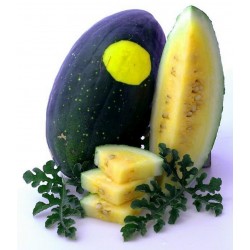
Yellow Watermelon Seeds...
Price
€1.95
SKU: V 40
Seeds Gallery Com,
5/
5
<h2><strong>Yellow Watermelon Seeds - Moon and Stars</strong></h2>
<h2><strong style="color: #ff0000;">Price for Package of<strong> 5 or 20 seeds.</strong></strong></h2>
<p>USDA Certified Organic. 90 days. Early 1900s GA family heirloom. Introduced 1987 by SESE. Years ago, a melon of this description was routinely shipped from Bermuda to some Southern states around Christmas time. Good flavor, the sweetest Moon and Stars variety. 15-35 lb fruits. Has some tolerance to disease and drought. Rinds has many small yellow stars and some moons. To serve, try halving melons and scooping out the insides using a melon ball scoop. Scallop the edges and fill with melon balls of red and yellow watermelon, muskmelon, and assorted fruit. </p>
<div>
<table style="width: 708px;" cellspacing="0" cellpadding="0" border="1">
<tbody>
<tr>
<td colspan="2" valign="top" style="width: 707px;">
<p><span style="color: #008000;"><strong>Sowing Instructions</strong></span></p>
</td>
</tr>
<tr>
<td valign="top" nowrap="nowrap" style="width: 178px;">
<p><span style="color: #008000;"><strong>Propagation:</strong></span></p>
</td>
<td valign="top" style="width: 529px;">
<p><span style="color: #008000;">Seeds</span></p>
</td>
</tr>
<tr>
<td valign="top" nowrap="nowrap" style="width: 178px;">
<p><span style="color: #008000;"><strong>Pretreat:</strong></span></p>
</td>
<td valign="top" style="width: 529px;">
<p><span style="color: #008000;">Damage the membranes of the seed. But not the sprouts! See Picture 5</span></p>
<p><span style="color: #008000;"> </span></p>
</td>
</tr>
<tr>
<td valign="top" nowrap="nowrap" style="width: 178px;">
<p><span style="color: #008000;"><strong>Stratification:</strong></span></p>
</td>
<td valign="top" style="width: 529px;">
<p><span style="color: #008000;">0</span></p>
</td>
</tr>
<tr>
<td valign="top" nowrap="nowrap" style="width: 178px;">
<p><span style="color: #008000;"><strong>Sowing Time:</strong></span></p>
</td>
<td valign="top" style="width: 529px;">
<p><span style="color: #008000;">all year round</span></p>
</td>
</tr>
<tr>
<td valign="top" nowrap="nowrap" style="width: 178px;">
<p><span style="color: #008000;"><strong>Sowing Depth:</strong></span></p>
</td>
<td valign="top" style="width: 529px;">
<p><span style="color: #008000;">0,5-1 cm</span></p>
</td>
</tr>
<tr>
<td valign="top" nowrap="nowrap" style="width: 178px;">
<p><span style="color: #008000;"><strong>Sowing Mix:</strong></span></p>
</td>
<td valign="top" style="width: 529px;">
<p><span style="color: #008000;">Coir or sowing mix + sand or perlite</span></p>
</td>
</tr>
<tr>
<td valign="top" nowrap="nowrap" style="width: 178px;">
<p><span style="color: #008000;"><strong>Germination temperature:</strong></span></p>
</td>
<td valign="top" style="width: 529px;">
<p><span style="color: #008000;">20 ° C</span></p>
</td>
</tr>
<tr>
<td valign="top" nowrap="nowrap" style="width: 178px;">
<p><span style="color: #008000;"><strong>Location:</strong></span></p>
</td>
<td valign="top" style="width: 529px;">
<p><span style="color: #008000;">bright + keep constantly moist not wet</span></p>
</td>
</tr>
<tr>
<td valign="top" nowrap="nowrap" style="width: 178px;">
<p><span style="color: #008000;"><strong>Germination Time:</strong></span></p>
</td>
<td valign="top" style="width: 529px;">
<p><span style="color: #008000;">1-6 weeks</span></p>
</td>
</tr>
<tr>
<td valign="top" nowrap="nowrap" style="width: 178px;">
<p><span style="color: #008000;"><strong>Watering:</strong></span></p>
</td>
<td valign="top" style="width: 529px;">
<p><span style="color: #008000;">Water regularly during the growing season</span></p>
</td>
</tr>
<tr>
<td valign="top" nowrap="nowrap" style="width: 178px;">
<p><span style="color: #008000;"><strong> </strong></span></p>
</td>
<td valign="top" style="width: 529px;">
<p align="center"><span style="font-size: 8pt; color: #008000;"><strong><em>Copyright © 2012</em></strong></span></p>
<p align="center"><span style="font-size: 8pt; color: #008000;"><strong><em>Seeds Gallery - Saatgut Galerie – Galerija semena.</em></strong></span></p>
<p align="center"><span style="color: #008000;"><span style="font-size: 8pt;"><strong><em>All Rights Reserved.</em></strong></span><strong></strong></span></p>
</td>
</tr>
</tbody>
</table>
</div>
V 40 (5 S)

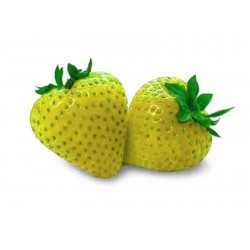
Strawberry Seeds Yellow Wonder
Price
€1.50
SKU: V 1 Y
Seeds Gallery Com,
5/
5
<!DOCTYPE html>
<html>
<head>
<meta http-equiv="Content-Type" content="text/html; charset=UTF-8" />
</head>
<body>
<h2><strong>Strawberry Seeds Yellow Wonder</strong></h2>
<h2><span style="color: #ff0000;"><strong>Price for Package of 10 , 50 , 100 seeds.</strong></span></h2>
<div>A compact, non trailing variety giving high yields of firm, sweet, aromatic fruit of an attractive yellow colour. The yellow fruit do not attract birds, thus bird damage is much less of a problem than with traditional red strawberries. Very easy to grow. Prefers full sun or part-sun.
<div>
<table border="1" cellspacing="0" cellpadding="0">
<tbody>
<tr>
<td colspan="2" valign="top" width="100%">
<p align="center"><span style="color: #008000;"><strong>Sowing Instructions</strong></span></p>
</td>
</tr>
<tr>
<td valign="top" nowrap="nowrap">
<p align="center"><span style="color: #008000;"><strong>Propagation:</strong></span></p>
</td>
<td valign="top">
<p align="center"><span style="color: #008000;">Seeds</span></p>
</td>
</tr>
<tr>
<td valign="top" nowrap="nowrap">
<p align="center"><span style="color: #008000;"><strong>Pretreat:</strong></span></p>
</td>
<td valign="top">
<p align="center"><span style="color: #008000;">0</span></p>
</td>
</tr>
<tr>
<td valign="top" nowrap="nowrap">
<p align="center"><span style="color: #008000;"><strong>Stratification:</strong></span></p>
</td>
<td valign="top">
<p align="center"><span style="color: #008000;">0</span></p>
</td>
</tr>
<tr>
<td valign="top" nowrap="nowrap">
<p align="center"><span style="color: #008000;"><strong>Sowing Time:</strong></span></p>
</td>
<td valign="top">
<p align="center"><span style="color: #008000;">all year round</span></p>
</td>
</tr>
<tr>
<td valign="top" nowrap="nowrap">
<p align="center"><span style="color: #008000;"><strong>Sowing Depth:</strong></span></p>
</td>
<td valign="top">
<p align="center"><span style="color: #008000;">Needs Light to germinate! Just sprinkle on the surface of the substrate + gently press</span></p>
</td>
</tr>
<tr>
<td valign="top" nowrap="nowrap">
<p align="center"><span style="color: #008000;"><strong>Sowing Mix:</strong></span></p>
</td>
<td valign="top">
<p align="center"><span style="color: #008000;">Coir or sowing mix + sand or perlite</span></p>
</td>
</tr>
<tr>
<td valign="top" nowrap="nowrap">
<p align="center"><span style="color: #008000;"><strong>Germination temperature:</strong></span></p>
</td>
<td valign="top">
<p align="center"><span style="color: #008000;">20-25°C</span></p>
</td>
</tr>
<tr>
<td valign="top" nowrap="nowrap">
<p align="center"><span style="color: #008000;"><strong>Location:</strong></span></p>
</td>
<td valign="top">
<p align="center"><span style="color: #008000;">bright + keep constantly moist not wet</span></p>
</td>
</tr>
<tr>
<td valign="top" nowrap="nowrap">
<p align="center"><span style="color: #008000;"><strong>Germination Time:</strong></span></p>
</td>
<td valign="top">
<p align="center"><span style="color: #008000;">1 - 8 weeks</span></p>
</td>
</tr>
<tr>
<td valign="top" nowrap="nowrap">
<p align="center"><span style="color: #008000;"><strong>Watering:</strong></span></p>
</td>
<td valign="top">
<p align="center"><span style="color: #008000;">Water regularly during the growing season</span></p>
</td>
</tr>
<tr>
<td valign="top" nowrap="nowrap"> </td>
<td valign="top">
<p align="center"><br /><span style="color: #008000;"><em>Copyright © 2012 Seeds Gallery - Saatgut Galerie - Galerija semena. </em><em>All Rights Reserved.</em></span></p>
</td>
</tr>
</tbody>
</table>
<p> </p>
</div>
</div>
</body>
</html>
V 1 Y (10 S)

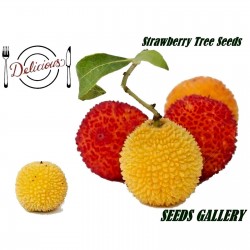
Strawberry Tree Seeds...
Price
€1.65
SKU: V 42
Seeds Gallery Com,
5/
5
<!DOCTYPE html>
<html>
<head>
<meta http-equiv="Content-Type" content="text/html; charset=UTF-8" />
</head>
<body>
<h2><strong>Strawberry Tree Seeds (Arbutus Unedo)</strong></h2>
<h2><span style="color: #ff0000;"><strong>Price for Package of 10 seeds.</strong></span></h2>
<p><i><b>Arbutus unedo</b></i>, the<span> </span><b>strawberry tree</b>, is an<span> </span>evergreen<span> </span>shrub<span> </span>or small<span> </span>tree<span> </span>in the<span> </span>family<span> </span>Ericaceae, native to the<span> </span>Mediterranean region<span> </span>and western Europe north to western France and Ireland. Due to its presence in southwest and northwest Ireland, it is known as either "Irish strawberry tree", or cain or cane apple (from the Irish name for the tree,<span> </span><i>caithne</i><sup id="cite_ref-2" class="reference">[2]</sup>), or sometimes<span> </span>Killarney<span> </span>strawberry tree.</p>
<p>Despite the name, it is not the source of the common strawberry, which is obtained from<span> </span><i>Fragaria</i><span> </span>×<span> </span><i>ananassa</i>, an unrelated plant.</p>
<h2><span class="mw-headline" id="Taxonomy">Taxonomy</span></h2>
<p><i>Arbutus unedo</i><span> </span>was one of the many species described by<span> </span>Carl Linnaeus<span> </span>in Volume One of his landmark 1753 work<span> </span><i>Species Plantarum</i>, giving it the name it still bears today.</p>
<p>A study published in 2001 which analyzed<span> </span>ribosomal DNA<span> </span>from<span> </span><i>Arbutus</i><span> </span>and related genera found<span> </span><i>Arbutus</i><span> </span>to be<span> </span>paraphyletic, and<span> </span><i>A. unedo</i><span> </span>to be closely related to the other<span> </span>Mediterranean Basin<span> </span>species such as<span> </span><i>A. andrachne</i><span> </span>and<span> </span><i>A. canariensis</i><span> </span>and not to the western North American members of the genus.</p>
<p><i>Arbutus unedo</i><span> </span>and<span> </span><i>A. andrachne</i><span> </span>hybridise naturally where their ranges overlap; the<span> </span>hybrid<span> </span>has been named<span> </span><i>Arbutus × andrachnoides</i><span> </span>(syn.<span> </span><i>A. × hybrida</i>, or<span> </span><i>A. andrachne × unedo</i>), inheriting traits of both parent species, though fruits are not usually borne freely, and as a hybrid is unlikely to breed true from seed. It is sold in California as Arbutus x Marina named for a district in San Francisco where it was hybridized.</p>
<h2><span class="mw-headline" id="Description">Description</span></h2>
<div class="thumb tleft">
<div class="thumbinner"><img alt="" src="https://upload.wikimedia.org/wikipedia/commons/thumb/1/14/Deux_arbouses.JPG/220px-Deux_arbouses.JPG" width="220" height="165" class="thumbimage" />
<div class="thumbcaption">
<div class="magnify"></div>
Arbutus unedo fruit</div>
</div>
</div>
<div class="thumb tright">
<div class="thumbinner"><img alt="" src="https://upload.wikimedia.org/wikipedia/commons/thumb/f/f3/Maginje_na_Kolo%C4%8Depu.JPG/220px-Maginje_na_Kolo%C4%8Depu.JPG" width="220" height="165" class="thumbimage" />
<div class="thumbcaption">
<div class="magnify"></div>
ripe and unripe fruits and flowers</div>
</div>
</div>
<div class="thumb tright">
<div class="thumbinner"><img alt="" src="https://upload.wikimedia.org/wikipedia/commons/thumb/f/f2/Badaia_-_Barranco_de_los_Goros_-_Madro%C3%B1o_02.jpg/220px-Badaia_-_Barranco_de_los_Goros_-_Madro%C3%B1o_02.jpg" width="220" height="165" class="thumbimage" />
<div class="thumbcaption">
<div class="magnify"></div>
Flowers</div>
</div>
</div>
<div class="thumb tright">
<div class="thumbinner"><img alt="" src="https://upload.wikimedia.org/wikipedia/commons/thumb/8/87/Arbutus_or_Shammari_%28Bayda-Libya%29.jpg/220px-Arbutus_or_Shammari_%28Bayda-Libya%29.jpg" width="220" height="124" class="thumbimage" />
<div class="thumbcaption">
<div class="magnify"></div>
Arbutus tree near<span> </span>Bayda<span> </span>in Libya</div>
</div>
</div>
<div class="thumb tright">
<div class="thumbinner"><img alt="" src="https://upload.wikimedia.org/wikipedia/commons/thumb/8/8b/Strawberry_tree_berry.jpg/220px-Strawberry_tree_berry.jpg" width="220" height="295" class="thumbimage" />
<div class="thumbcaption">
<div class="magnify"></div>
Fruit</div>
</div>
</div>
<p><i>Arbutus unedo</i><span> </span>grows to 5–10 m (16–33 ft) tall, rarely up to 15 m (49 ft), with a trunk diameter of up to 80 cm (31 in). It grows in<span> </span>hardiness zones<span> </span>7–10.</p>
<p>The<span> </span>leaves<span> </span>are dark green and glossy, 5–10 cm (2–4 in) long and 2–3 cm (0.79–1.18 in) broad, with a serrated margin.</p>
<p>The<span> </span>hermaphrodite<span> </span>flowers<span> </span>are white (rarely pale pink), bell-shaped, 4–6 mm (0.16–0.24 in) diameter, produced panicles of 10–30 together in autumn. They are pollinated by<span> </span>bees, and have a mild sweet scent.</p>
<p>The<span> </span>fruit<span> </span>is a red berry, 1–2 cm (0.39–0.79 in) diameter, with a rough surface. It matures in about 12 months, in autumn, at the same time as the next flowering. It is edible; the fruit is sweet when reddish. Seeds are often<span> </span>dispersed<span> </span>by<span> </span>frugivorous<span> </span>birds</p>
<p>The name<span> </span><i><b>unedo</b></i><span> </span>is attributed to<span> </span>Pliny the Elder, who allegedly claimed that "<i>unum tantum edo</i>", meaning "I eat only one".<span> </span>It is not known whether he meant that the fruit was so good he could eat only one, or whether he meant that the fruit was uninteresting so he ate only one.</p>
<h2><span class="mw-headline" id="Distribution">Distribution</span></h2>
<p><i>Arbutus unedo</i><span> </span>is widespread in the<span> </span>Mediterranean region: in Portugal, Spain and southeastern France; southward in Algeria, Morocco, Libya, and Tunisia, and eastward in Italy, Slovenia, Croatia, Greece, Turkey, Lebanon, Syria and Israel. It is also found in western France, Albania, Bulgaria and southwestern Ireland.</p>
<p>Its<span> </span>disjunct distribution, with an isolated<span> </span>relict<span> </span>population in southwestern and northwestern Ireland, notably in<span> </span>Killarney<span> </span>and around<span> </span>Lough Gill<span> </span>in<span> </span>County Sligo, which is its most northerly stand in the world, is a remnant of former broader distribution during the milder climate of the<span> </span>Atlantic period, the warmest and moistest<span> </span>Blytt-Sernander<span> </span>period, when the climate was generally warmer than today. The red-flowered variant, named<span> </span><i>A. unedo rubra</i><span> </span>by<span> </span>William Aiton<span> </span>in 1785, was discovered growing wild in Ireland in 1835.</p>
<h2><span class="mw-headline" id="Cultivation">Cultivation</span></h2>
<p><i>Arbutus unedo</i><span> </span>is quite an easy plant to cultivate, and is adaptable to many climates. Once established it is fairly<span> </span>drought resistant,<span> </span>frost<span> </span>resistant,<span> </span>shade tolerant<span> </span>and<span> </span>salt tolerant.</p>
<p>Lower production of fruit mass has however been reported in case of summer droughts, and frosts in flowering time was seen to decrease the numbers of fruits.</p>
<p><i>Arbutus unedo</i><span> </span>is naturally adapted to dry summer climates, and has become a very popular ornamental plant in<span> </span>California<span> </span>and the rest of the west coast of<span> </span>North America. It can grow easily in<span> </span>USDA hardiness zone<span> </span>7 or warmer.</p>
<p>It also grows well in the cool, wet summers of western<span> </span>Ireland<span> </span>and<span> </span>England, and temperate regions of Europe and Asia.<span> </span>Pests<span> </span>include<span> </span>scales<span> </span>and<span> </span>thrips, and diseases include<span> </span>anthracnose,<span> </span><i>Phytophthora</i>, root rot, and<span> </span>rust.<sup class="noprint Inline-Template Template-Fact">[<i><span title="This claim needs references to reliable sources. (September 2017)">citation needed</span></i>]</sup></p>
<p>Unlike most of the Ericaceae,<span> </span><i>A. unedo</i><span> </span>grows well in<span> </span>basic<span> </span>(limy)<span> </span>pH soils, even though it does better in more acidic soils.</p>
<p>The fruit production is not very high and is highly variable on the<span> </span>weather, and that may be part of the reason this plant is not much cultivated. The average yield in a two years study is around 46<span> </span>kg<span> </span>per<span> </span>hectare, and 180 grams per cubic metre of crown.<sup id="cite_ref-12" class="reference">[12]</sup><span> </span>However, very little work has so far been done in terms of genotype selection.</p>
<p><i>Arbutus unedo</i><span> </span>has been seen to form a<span> </span>mycorrhizal<span> </span>relationship. Inoculation with<span> </span><i>Pisolithus tinctorius</i><span> </span>has shown to greatly improve the plants root mass, size, tolerance to drought and nutritional status.<sup id="cite_ref-14" class="reference">[14]</sup><sup id="cite_ref-15" class="reference">[15]</sup></p>
<p>In cultivation in the UK, the<span> </span>form<span> </span><i>A. unedo</i><span> </span>f.<span> </span><i>rubra</i><sup id="cite_ref-16" class="reference">[16]</sup><span> </span>and the<span> </span>cultivar<span> </span>‘Atlantic’<sup id="cite_ref-RHSPF1_17-0" class="reference">[17]</sup><span> </span>have gained the<span> </span>Royal Horticultural Society’s<span> </span>Award of Garden Merit</p>
<h3><span class="mw-headline" id="Propagation">Propagation</span></h3>
<p>Propagation<span> </span>can be done via<span> </span>seed,<span> </span>layering, or<span> </span>cutting.</p>
<p>The seed should undergo a one month<span> </span>cold stratification<span> </span>period,<span> </span>then soaked for 5 to 6 days in warm water to improve germination success. Seedlings are prone to damp, and should be cared in the first year.</p>
<p>Germination rate is low, rarely over 20%.</p>
<p>Layering can take up to two years, but has a good success rate, while cutting is done with a 15–20 cm (5.9–7.9 in) long mature wood, preferably with a heel in November to December. The success rate however is not very high.<sup id="cite_ref-20" class="reference">[20]</sup></p>
<h2><span class="mw-headline" id="Uses">Uses</span></h2>
<h3><span class="mw-headline" id="Culinary_uses">Culinary uses</span></h3>
<div class="thumb tleft">
<div class="thumbinner"><img alt="" src="https://upload.wikimedia.org/wikipedia/commons/thumb/2/22/Arbutus_unedo_crumble_cake.jpg/220px-Arbutus_unedo_crumble_cake.jpg" width="220" height="156" class="thumbimage" />
<div class="thumbcaption">
<div class="magnify"></div>
<i>Arbutus unedo</i><span> </span>crumble cake</div>
</div>
</div>
<div class="thumb tright">
<div class="thumbinner"><img alt="" src="https://upload.wikimedia.org/wikipedia/commons/thumb/4/4c/Bowl_of_Strawberry_Tree_berries.jpg/220px-Bowl_of_Strawberry_Tree_berries.jpg" width="220" height="295" class="thumbimage" />
<div class="thumbcaption">
<div class="magnify"></div>
Bowl of strawberry fruits</div>
</div>
</div>
<p><i>Arbutus unedo'</i>s fruits have a high content of<span> </span>sugars<span> </span>(40%), and<span> </span>antioxidant<span> </span>vitamins such as<span> </span>vitamin C,<span> </span>beta-carotene,<span> </span>niacin,<span> </span>tocopherols, and organic acids that are precursors to<span> </span>omega-3<span> </span>and<span> </span>omega-6 fatty acids<span> </span>(nearly 9%).<sup id="cite_ref-21" class="reference">[21]</sup><sup id="cite_ref-22" class="reference">[22]</sup><span> </span>They are edible fresh, but that is an uncommon consumption, especially because the mature fruit tends to bruise very easily, making transportation difficult.</p>
<p>They are used mostly for jam, marmalades, yogurt and<span> </span>alcoholic beverages,<sup id="cite_ref-23" class="reference">[23]</sup><sup id="cite_ref-24" class="reference">[24]</sup><span> </span>such as the Portuguese<span> </span><i>medronho</i>, a type of strong brandy. Many regions of<span> </span>Albania<span> </span>prepare the traditional drink<span> </span>rakia<span> </span>from the fruits of the plant (mare or kocimare in<span> </span>Albanian), hence comes the name of the drink "raki kocimareje". In order to reduce the high content of<span> </span>methanol<span> </span>in the drink, the spirit is distilled twice.</p>
<p>The flowers are pollinated by<span> </span>bees, and the resulting<span> </span>honey<span> </span>is bitter tasting but still considered a delicacy.</p>
<h3><span class="mw-headline" id="Herbal_medicine">Herbal medicine</span></h3>
<p><i>Arbutus unedo'</i>s leaves have been employed in traditional and<span> </span>folk medicine<span> </span>in the form of<span> </span>a decoction<span> </span>having the following properties: astringent, diuretic, urinary anti-septic, antiseptic, intoxicant, rheumatism, tonic, and more recently, in the therapy of hypertension and diabetes.<sup id="cite_ref-28" class="reference"></sup></p>
<p>The leaves are reported to have a high concentration of<span> </span>flavonol<span> </span>antioxidants, especially<span> </span>quercitin, best extracted with a decoction, and together with the fruits are a source of antioxidants.<sup id="cite_ref-30" class="reference"></sup></p>
<p>The leaves also have<span> </span>anti-inflammatory<span> </span>properties<sup id="cite_ref-31" class="reference">[31]</sup><sup class="noprint Inline-Template Template-Fact">[<i><span title="This claim needs references to reliable secondary sources. (September 2017)">non-primary source needed</span></i>]</sup></p>
<h3><span class="mw-headline" id="Ecological_design">Ecological design</span></h3>
<p>In<span> </span>landscape design,<span> </span>ecosystem restoration<span> </span>or<span> </span>permaculture<span> </span>based designs,<span> </span><i>A. unedo</i><span> </span>can have many purposes. While the ornamental one is the most common, this can be a valuable plant also for restoring degraded ecosystems and preventing<span> </span>desertification. Being a pioneer plant and growing well also in poor soils, can be used in a wide array of situations.</p>
<ul>
<li>The<span> </span>flowers<span> </span>are a significant source of nectar and pollen for bees, while the fruits are food for the birds.</li>
<li>Its salt tolerance, coupled with it being an<span> </span>evergreen, make it a good choice for wind barriers in lands close to the sea.</li>
<li><i>A. unedo</i><span> </span>is<span> </span>fire resistant<span> </span>(can regrow after a fire), and being a pioneer plant can contribute to the discontinuity of fire-prone pines and eucalyptus monocultures;<sup id="cite_ref-32" class="reference">[32]</sup><span> </span>for the same reasons it is a good candidate for reforestation in Mediterranean areas.<sup id="cite_ref-33" class="reference">[33]</sup></li>
<li>The dense foliage throughout the year can be a shelter for insects and small animals during the<span> </span>winter.</li>
<li>Its extensive<span> </span>root system<span> </span>can help in the soil stabilization process.<sup id="cite_ref-34" class="reference">[34]</sup></li>
</ul>
<h3><span class="mw-headline" id="Other_uses">Other uses</span></h3>
<ul>
<li>The wood is quite hard and well suited for a various uses such as<span> </span>fire wood<span> </span>and to make<span> </span>pipes. Since it doesn't usually grow straight, it is not well suited for construction or similar uses.</li>
<li>The tree is also grown as an ornamental plant, because of the nice looking and smelling of the flowers and the fruit, the interesting presence at the same time of fruits and flowers on the plant and because it is an evergreen. It is used as a single or multi-trunked<span> </span>ornamental tree, and as a specimen or<span> </span>hedge<span> </span>shrub<span> </span>in gardens and public landscapes.</li>
</ul>
<h2><span class="mw-headline" id="History">History</span></h2>
<div class="thumb tright">
<div class="thumbinner"><img alt="" src="https://upload.wikimedia.org/wikipedia/commons/thumb/7/7d/Badaia_-_Barranco_de_los_Goros_-_Madro%C3%B1o_04.jpg/170px-Badaia_-_Barranco_de_los_Goros_-_Madro%C3%B1o_04.jpg" width="170" height="244" class="thumbimage" />
<div class="thumbcaption">
<div class="magnify"></div>
<i>Arbutus unedo</i>: habit</div>
</div>
</div>
<p>Its Mediterranean habitat, elegant details of leaf and habit and dramatic show of fruit with flowers made<span> </span><i>Arbutus unedo</i><span> </span>notable in<span> </span>Classical Antiquity, when it was called Andrachne, and for which Theophrastos (4th c. BCE) wrote about it, as well as the ancient army medical herbalogist Pedanios Dioscorides [De Materia Medica, Book II-150]; in addition,<span> </span>Pliny<span> </span>thought it should not be planted where bees are kept, for the bitterness it imparts to honey.</p>
<p>The first signs of its importation into northern European gardens was to 16th-century England from Ireland. In 1586 a correspondent in Ireland sent plants to the Elizabethan courtiers<span> </span>Lord Leicester<span> </span>and<span> </span>Sir Francis Walsingham.<sup id="cite_ref-Coats_35-0" class="reference">[35]</sup><span> </span>An earlier description by<span> </span>Rev. William Turner<span> </span>(<i>The Names of Herbes</i>, 1548) was probably based on hearsay. The Irish association of<span> </span><i>Arbutus</i><span> </span>in English gardens is reflected in the inventory taken in 1649 of Henrietta Maria's<span> </span>Wimbledon: "one very fayre tree, called the Irish arbutis standing in the midle parte of the sayd kitchin garden, very lovely to look upon"<sup id="cite_ref-Coats_35-1" class="reference">[35]</sup><span> </span>By the 18th century<span> </span><i>Arbutus unedo</i><span> </span>was well known enough in English gardens for<span> </span>Batty Langley<span> </span>to make the bold and impractical suggestion that it might be used for hedges, though it "will not admit of being clipped as other evergreens are."</p>
<p>In the United States,<span> </span>Thomas Jefferson<span> </span>lists the plant in his<span> </span>Monticello<span> </span>gardens in 1778.</p>
<p>The form<span> </span><i>A. unedo</i><span> </span>f.<span> </span><i>rubra</i><span> </span>and the hybrid<span> </span><i>A.</i><span> </span>×<span> </span><i>andrachnoides</i>,<sup id="cite_ref-38" class="reference">[38]</sup><span> </span>have gained the<span> </span>Royal Horticultural Society's<span> </span>Award of Garden Merit.</p>
<h3><span class="mw-headline" id="Symbolic_uses">Symbolic uses</span></h3>
<div class="thumb tright">
<div class="thumbinner"><img alt="" src="https://upload.wikimedia.org/wikipedia/commons/thumb/8/88/Hieronymus_Bosch_-_The_Garden_of_Earthly_Delights_-_Garden_of_Earthly_Delights_%28Ecclesia%27s_Paradise%29.jpg/220px-Hieronymus_Bosch_-_The_Garden_of_Earthly_Delights_-_Garden_of_Earthly_Delights_%28Ecclesia%27s_Paradise%29.jpg" width="220" height="236" class="thumbimage" />
<div class="thumbcaption">
<div class="magnify"></div>
Central panel of<span> </span><i>The Garden of Earthly Delights</i><span> </span>by<span> </span>Hieronymus Bosch, described by<span> </span>José de Sigüenza<span> </span>as "The Picture of the Strawberry Tree".</div>
</div>
</div>
<p><i>The Garden of Earthly Delights</i>, a painting by<span> </span>Hieronymus Bosch, was originally listed by<span> </span>José de Sigüenza, in the inventory of<span> </span>the Spanish Crown<span> </span>as<span> </span><i>La Pintura del Madroño</i><span> </span>– "The Painting of the Strawberry Tree".<sup id="cite_ref-39" class="reference">[39]</sup></p>
<p>The tree makes up part of the<span> </span>Coat of arms of Madrid<span> </span>(<i>El oso y el madroño</i>, The Bear and the Strawberry Tree) of the city of<span> </span>Madrid,<span> </span>Spain. In the center of the city (Puerta del Sol) there is a statue of a bear eating the fruit of the<span> </span><i>Madroño</i><span> </span>tree. The image appears on city crests, taxi cabs, man-hole covers, and other city infrastructure. The fruit of the<span> </span><i>Madroño</i>tree ferments on the tree if left to ripen, so some of the bears become drunk from eating the fruits.<sup class="noprint Inline-Template Template-Fact">[<i><span title="This claim needs references to reliable sources. (June 2011)">citation needed</span></i>]</sup></p>
<div class="thumb tright">
<div class="thumbinner"><img alt="" src="https://upload.wikimedia.org/wikipedia/commons/thumb/6/67/Escudo_de_Madrid.svg/170px-Escudo_de_Madrid.svg.png" width="170" height="247" class="thumbimage" />
<div class="thumbcaption">
<div class="magnify"></div>
A bear and a<span> </span><i>madroño</i>(strawberry tree) are the symbol of<span> </span>Madrid</div>
</div>
</div>
<div class="thumb tright">
<div class="thumbinner"><img alt="" src="https://upload.wikimedia.org/wikipedia/commons/thumb/4/4d/El_oso_y_el_madro%C3%B1o_-_02.jpg/170px-El_oso_y_el_madro%C3%B1o_-_02.jpg" width="170" height="255" class="thumbimage" />
<div class="thumbcaption">
<div class="magnify"></div>
Statue of the Bear and the Strawberry Tree, Madrid</div>
</div>
</div>
<p>The tree is mentioned by Roman poet<span> </span>Ovid, in Book I: 89–112 "The Golden Age" of his<span> </span><i>Metamorphoses</i>: "Contented with food that grew without cultivation, they collected mountain strawberries and the fruit of the strawberry tree, wild cherries, blackberries clinging to the tough brambles, and acorns fallen from Jupiter’s spreading oak-tree."<sup id="cite_ref-40" class="reference">[40]</sup></p>
<p>The name of the Italian promontory<span> </span>Mount Conero, situated directly south of the port of<span> </span>Ancona<span> </span>on the<span> </span>Adriatic Sea, derives from the Greek name κόμαρος (komaròs) indicating the strawberry tree which is common on the slopes of the mountain.<sup id="cite_ref-41" class="reference">[41]</sup><span> </span>Mount Conero, the only coastal high point on the Adriatic sea between<span> </span>Trieste<span> </span>and the<span> </span>Gargano<span> </span>massif in the region of<span> </span>Apulia, assists navigators to sail across the Adriatic sea since ancient times.</p>
<div class="thumb tright">
<div class="thumbinner"><img alt="" src="https://upload.wikimedia.org/wikipedia/commons/thumb/e/eb/Sirolo-vista_conero.jpg/220px-Sirolo-vista_conero.jpg" width="220" height="146" class="thumbimage" />
<div class="thumbcaption">
<div class="magnify"></div>
Mount Conero, whose name is derived from the<span> </span>Greek<span> </span>κόμαρος (komaròs) and indicates the strawberry tree which is common on the slopes of the mountain.</div>
</div>
</div>
<p>The poet<span> </span>Giovanni Pascoli<span> </span>dedicated a poem to the strawberry tree. He refers to the<span> </span>Aeneid<span> </span>passage in which<span> </span>Pallas, killed by<span> </span>Turnus, was posed on branches of a strawberry tree. He saw in the colours of that plant a prefiguration of the<span> </span>flag of Italy<span> </span>and considered Pallas the first<span> </span><i>national cause martyr</i>.<sup id="cite_ref-43" class="reference">[43]</sup><span> </span>Pascoli's ode says:</p>
<div class="div-col columns column-width">
<p><span class="languageicon">(in Italian)</span></p>
<blockquote class="templatequote">
<p>O verde albero italico, il tuo maggio<i></i></p>
<p><i>è nella bruma: s'anche tutto muora,</i></p>
<p><i>tu il giovanile gonfalon selvaggio</i></p>
<p><i>spieghi alla bora</i></p>
</blockquote>
<blockquote class="templatequote">
<p>Oh green Italian tree, your May month<i></i></p>
<p><i>is in the mist: if everything die,</i></p>
<p><i>you, the youthful wild banner</i></p>
<p><i>unfold to the northern wind</i></p>
</blockquote>
</div>
<p>In the Italian<span> </span>Risorgimento<span> </span>the strawberry tree, because of its autumnal colours, the same colours of the Italian flag, at the same time red for fruits and white for flowers, beyond the green colour of leaves, was considered, indeed, a symbol of the flag.</p>
<h2><a href="https://en.wikipedia.org/wiki/Arbutus_unedo" target="_blank" title="Source: Wikipedia Arbutus unedo, the Strawberry Tree" rel="noreferrer noopener"><strong>Source: Wikipedia Arbutus unedo, the Strawberry Tree</strong></a></h2>
<div>
<table cellspacing="0" cellpadding="0" border="1">
<tbody>
<tr>
<td colspan="2" width="100%" valign="top">
<p><span style="color: #008000;"><strong>Sowing Instructions</strong></span></p>
</td>
</tr>
<tr>
<td valign="top" nowrap="nowrap">
<p><span style="color: #008000;"><strong>Propagation:</strong></span></p>
</td>
<td valign="top">
<p><span style="color: #008000;">Seeds</span></p>
</td>
</tr>
<tr>
<td valign="top" nowrap="nowrap">
<p><span style="color: #008000;"><strong>Pretreat:</strong></span></p>
</td>
<td valign="top">
<p><span style="color: #008000;">0</span></p>
</td>
</tr>
<tr>
<td valign="top" nowrap="nowrap">
<p><span style="color: #008000;"><strong>Stratification:</strong></span></p>
</td>
<td valign="top">
<p><span style="color: #008000;">1-2 months in moist soil at 2-5 ° C in a refrigerator </span></p>
</td>
</tr>
<tr>
<td valign="top" nowrap="nowrap">
<p><span style="color: #008000;"><strong>Sowing Time:</strong></span></p>
</td>
<td valign="top">
<p><span style="color: #008000;">all year round> Autumn / Winter preferred</span></p>
</td>
</tr>
<tr>
<td valign="top" nowrap="nowrap">
<p><span style="color: #008000;"><strong>Sowing Depth:</strong></span></p>
</td>
<td valign="top">
<p><span style="color: #008000;">Cover lightly with substrate</span></p>
</td>
</tr>
<tr>
<td valign="top" nowrap="nowrap">
<p><span style="color: #008000;"><strong>Sowing Mix:</strong></span></p>
</td>
<td valign="top">
<p><span style="color: #008000;">Coir or sowing mix + sand or perlite</span></p>
</td>
</tr>
<tr>
<td valign="top" nowrap="nowrap">
<p><span style="color: #008000;"><strong>Germination temperature:</strong></span></p>
</td>
<td valign="top">
<p><span style="color: #008000;">18-20 ° C</span></p>
</td>
</tr>
<tr>
<td valign="top" nowrap="nowrap">
<p><span style="color: #008000;"><strong>Location:</strong></span></p>
</td>
<td valign="top">
<p><span style="color: #008000;">bright + keep constantly moist not wet</span></p>
</td>
</tr>
<tr>
<td valign="top" nowrap="nowrap">
<p><span style="color: #008000;"><strong>Germination Time:</strong></span></p>
</td>
<td valign="top">
<p><span style="color: #008000;">until it germinates </span></p>
</td>
</tr>
<tr>
<td valign="top" nowrap="nowrap">
<p><span style="color: #008000;"><strong>Watering:</strong></span></p>
</td>
<td valign="top">
<p><span style="color: #008000;">Water regularly during the growing season</span></p>
</td>
</tr>
<tr>
<td valign="top" nowrap="nowrap">
<p><span style="color: #008000;"><strong> </strong></span></p>
</td>
<td valign="top">
<p><br /><span style="color: #008000;"><em>Copyright © 2012 Seeds Gallery - Saatgut Galerie - Galerija semena. </em><em>All Rights Reserved.</em><em></em></span></p>
</td>
</tr>
</tbody>
</table>
</div>
</body>
</html>
V 42


Variety from Armenia
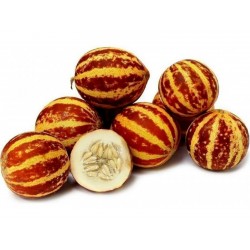
Armenian Tigger Melon Seeds
Price
€4.95
SKU: V 46
Seeds Gallery Com,
5/
5
<meta http-equiv="Content-Type" content="text/html; charset=UTF-8" />
<h2><strong>Armenian Tigger Melon Seeds Organically Grown</strong></h2>
<h2><span style="color: #ff0000;"><strong>Price for Package of 5 seeds.</strong></span></h2>
<p>It is characterized by a strong and intense exotic taste and smell, and it is also very decorative. Small in size, the fruits weigh 150-450 g. Tigger melon plants can yield up to twenty melons per vine. The most amazing looking melon we have grown.</p>
<p>Tigger melons smooth rind has vertical variegations of rust orange and yellow. The melon's creamy, off-white flesh is juicy and sweet with a flavor that has been compared to that of Asian pear and cantaloupe. Like most muskmelon types, it offers a highly aromatic scent and has been known to perfume the entire room they are in when at their peak of ripeness. Tigger melons will grow to be approximately the size of a softball and weigh a modest one pound when fully mature.</p>
<p>The Tigger melon was originally discovered in ancient western Armenia near the Tigris River. Like most melon varieties it prefers the warm to hot growing days of summer in temperate and Mediterranean regions. Growing on climbing vines the petite size of the Tigger melon makes it ideal for trellising allowing it to be grown in relatively small spaces.</p>
<p><strong>APPEARANCE </strong></p>
<p>Gorgeous, bright yellow and rusty orange tiger-striped skin with pale, tan flesh</p>
<p><strong>AROMA </strong></p>
<p>This little baby just fills the room with fragrance while innocently sitting there on the table. Then when you cut it, oh when you cut it, it just explodes with the most divinely strong and sweet melony smell. This is what falling in love smells like.</p>
<p><strong>TEXTURE </strong></p>
<p>Pretty firm for melon and juicy</p>
<p><strong>TASTE</strong></p>
<p>Mellow vanilla flavor with little sweetness</p>
V 46 (5 S)

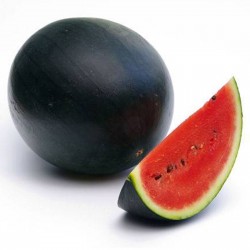
Black Sweet Watermelon Seeds
Price
€2.50
SKU: V 134 B
Seeds Gallery Com,
5/
5
<h2 class=""><strong>Black Sweet Watermelon Seeds</strong></h2>
<h2><span style="color: #ff0000;"><strong>Price for Package of </strong></span><span style="color: #ff0000;" class=""><strong>25 (1g) </strong></span><span style="color: #ff0000;"><strong>seeds.</strong></span></h2>
<div>The finest seeds through the finest seed selecting process with our leading technology to ensure the quality of the seeds with firm vigor, great disease tolerance as well as very high germination</div>
<div>Common Name: Black Sweet Watermelon Seeds</div>
<div>Scientific Name: Citrullus vulgaris Schrad</div>
<div>Soil: Any soil</div>
<div>Water: morning and evening</div>
<div>Fertilizer: 15-15-15</div>
<div>Harvest: - days</div>
<div>
<p>% Purity : 100</p>
</div>
<div>% Germ.: 89</div><script src="//cdn.public.n1ed.com/G3OMDFLT/widgets.js"></script>
V 134 B (25 S)


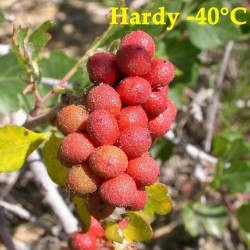
Skunkbush Sumac Seeds (rhus...
Price
€2.90
SKU: V 49
Seeds Gallery Com,
5/
5
<h2><strong>Skunkbush Sumac Seeds (rhus trilobata) </strong><strong>Exotic Fruit<br /></strong></h2>
<h2><span style="color: #ff0000;"><strong>Price for Package of 5 seeds.</strong></span></h2>
<p>A low deciduous shrub that offers attractive flowers in spring and bright fruits and foliage in fall, skunkbush sumac is native to western North America. In mid-spring before the leaves emerge, conspicuous clusters of pale yellow flowers appear at the stem tips. Small berries follow, ripening red in late summer. Resembling poison ivy foliage, the downy three-lobed leaves are mildly glossy and medium to dark green. The leaflets have blunt-toothed edges. Bruised leaves release a malodorous scent. In autumn, the foliage turns fiery colors. </p>
<p>Skunkbush sumac does best in full sun and moderately moist soil, with the brightest autumn color produced under such conditions. In drier soil plants are smaller. Use this extremely hardy shrub as a loose low screen at the edge of a woodland or building, or to clothe a bank or other erosion-prone site. Plants may sucker and form a thicket in some conditions.</p>
<p>Genus: Rhus </p>
<p>Species: trilobata</p>
<p>Common Name: Skunkbush Sumac</p>
<p>Other Name: Schamltzia trilobata, Rhus Canadensis var. Trilobata, Quailbush</p>
<p>Pre-treatment: required</p>
<p>Zone Hardiness Cold: 4</p>
<p>Zone Hardiness warm: 7</p>
<p>Plant Type: Small Shrub</p>
<p>Height / Width: 1-2m/2-3m</p>
<p>Growth rate: medium</p>
<p>Vegetation type: decidious</p>
<p>Leaf /Flower color: green/yellow-green</p>
<p>Light</p>
<p>Conditions : Light Conditions </p>
<p>Unless a site is completely exposed, light conditions will change during the day and even during the year. The northern and eastern sides of a house receive the least amount of light, with the northern exsposure being the shadiest. The western and southern sides of a house receive the most light and are conidered the hottest exposures due to intense afternoon sun.</p>
<p>You will notice that sun and shade patterns change during the day. The western side of a house may even be shady due to shadows cast by large trees or a structure from an adjacent property. If you have just bought a new home or just beginning to garden in your older home, take time to map sun and shade throughout the day. You will get a more accurate feel for your site's true light conditions.</p>
<p>Conditions : Full to Partial Sun </p>
<p>Full sunlight is needed for many plants to assume their full potential. Many of these plants will do fine with a little less sunlight, although they may not flower as heavily or their foliage as vibrant. Areas on the southern and western sides of buildings usually are the sunniest. The only exception is when houses or buildings are so close together, shadows are cast from neighboring properties. Full sun usually means 6 or more hours of direct unobstructed sunlight on a sunny day. Partial sun receives less than 6 hours of sun, but more than 3 hours. Plants able to take full sun in some climates may only be able to tolerate part sun in other climates. Know the culture of the plant before you buy and plant it!</p>
<p>Watering</p>
<p>Conditions : Moist and Well Drained </p>
<p>Moist and well drained means exactly what it sounds like. Soil is moist without being soggy because the texture of the soil allows excess moisture to drain away. Most plants like about 1 inch of water per week. Amending your soil with compost will help improve texture and water holding or draining capacity. A 3 inch layer of mulch will help to maintain soil moisture and studies have shown that mulched plants grow faster than non-mulched plants.</p>
<p>Planting</p>
<p>How-to : Planting Shrubs </p>
<p>Dig a hole twice the size of the root ball and deep enough to plant at the same level the shrub was in the container. If soil is poor, dig hole even wider and fill with a mixture half original soil and half compost or soil amendment.</p>
<p>Carefully remove shrub from container and gently separate roots. Position in center of hole, best side facing forward. Fill in with original soil or an amended mixture if needed as described above. For larger shrubs, build a water well. Finish by mulching and watering well.</p>
<p>If the plant is balled-and-burlapped, remove fasteners and fold back the top of natural burlap, tucking it down into hole, after you've positioned shrub. Make sure that all burlap is buried so that it won't wick water away from rootball during hot, dry periods. If synthetic burlap, remove if possible. If not possible, cut away or make slits to allow for roots to develop into the new soil. For larger shrubs, build a water well. Finish by mulching and watering well.</p>
<p>If shrub is bare-root, look for a discoloration somewhere near the base; this mark is likely where the soil line was. If soil is too sandy or too clayey, add organic matter. This will help with both drainage and water holding capacity. Fill soil, firming just enough to support shrub. Finish by mulching and watering well.</p>
<p>Problems</p>
<p>Diseases : Verticillium or Fusarium Wilt </p>
<p>Wilts may be contracted through infected seed, plant debris, or soil. This fungus begins and multiplies during the cool, moist season, becoming obvious when weather turns warm and dry. Plants wilt because the fungus damages their water conducting mechanisms. Overfertilization can worsen this problem. Able to overwinter in soil for many years, it is also carried and harbored in common weeds.</p>
<p>Prevention and Control: If possible, select resistant varieties. Keep nitrogen-heavy fertilizers to a minimum as well as over-irrigating as they encourage lush growth. Practice crop rotation and prune out or better yet remove infected plants.</p>
<p>Fungi : Powdery Mildew </p>
<p>Powdery Mildew is usually found on plants that do not have enough air circulation or adequate light. Problems are worse where nights are cool and days are warm and humid. The powdery white or gray fungus is usually found on the upper surface of leaves or fruit. Leaves will often turn yellow or brown, curl up, and drop off. New foliage emerges crinkled and distorted. Fruit will be dwarfed and often drops early.</p>
<p>Prevention and Control: Plant resistant varieties and space plants properly so they receive adequate light and air circulation. Always water from below, keeping water off the foliage. This is paramount for roses. Go easy on the nitrogen fertilizer. Apply fungicides according to label directions before problem becomes severe and follow directions exactly, not missing any required treatments. Sanitation is a must - clean up and remove all leaves, flowers, or debris in the fall and destroy.</p>
<p>Pest : Caterpillars </p>
<p>Caterpillars are the immature form of moths and butterflies. They are voracious feeders attacking a wide variety of plants. They can be highly destructive and are characterized as leaf feeders, stem borers, leaf rollers, cutworms and tent-formers.</p>
<p>Prevention and Control: keep weeds down, scout individual plants and remove caterpillars, apply labeled insecticides such as soaps and oils, take advantage of natural enemies such as parasitic wasps in the garden and use Bacillus thuringiensis (biological warfare) for some caterpillar species.</p>
<p>Fungi : Leaf Spots </p>
<p>Leaf spots are caused by fungi or bacteria. Brown or black spots and patches may be either ragged or circular, with a water soaked or yellow-edged appearance. Insects, rain, dirty garden tools, or even people can help its spread.</p>
<p>Prevention and Control: Remove infected leaves when the plant is dry. Leaves that collect around the base of the plant should be raked up and disposed of. Avoid overhead irrigation if possible; water should be directed at soil level. For fungal leaf spots, use a recommended fungicide according to label directions.</p>
<p>Pest : Scale Insects </p>
<p>Scales are insects, related to mealybugs, that can be a problem on a wide variety of plants - indoor and outdoor. Young scales crawl until they find a good feeding site. The adult females then lose their legs and remain on a spot protected by its hard shell layer. They appear as bumps, often on the lower sides of leaves. They have piercing mouth parts that suck the sap out of plant tissue. Scales can weaken a plant leading to yellow foliage and leaf drop. They also produce a sweet substance called honeydew (coveted by ants) which can lead to an unattractive black surface fungal growth called sooty mold.</p>
<p>Prevention and Control: Once established they are hard to control. Isolate infested plants away from those that are not infested. Cosnult your local garden center professional or Cooperative Extension office in your county for a legal recommendation regarding their control. Encourage natural enemies such as parasitic wasps in the garden.</p>
<p>Miscellaneous</p>
<p>Conditions : Deer Tolerant </p>
<p>There are no plants that are 100% deer resistant, but many that are deer tolerant. There are plants that deer prefer over others. You will find that what deer will or will not eat varies in different parts of the country. A lot of it has to do with how hungry they are. Most deer will sample everything at least once, decide if they like it or not and return if favorable. A fence is the good deer barrier. You may go for a really tall one (7 to 8 feet), or try 2 parallel fences, (4 to 5 feet apart). Use a wire mesh fence rather than board, since deer are capable of wiggling through a 12 inch space.</p>
<p>Conditions : Pollution Tolerant </p>
<p>Air pollution is becoming a bigger problem each day. Pollutants in our air damage plants. The plants are damaged by absorbing sulfur dioxide, ozone, peroxyacetyl nitrate, ethylene, and nitrogen dioxide through their pores. Cell membrane damage may result in leaf drop, blotched or burnt looking leaves, or off-colored tissue between veins. Vehicles and industrial processes are the key culprits and conditions worsen on hot summer days. Though planting only pollution tolerant plants is not the solution to this problem, it is a visual bandaid. Your Cooperative Extension Service may have a list of plants that are more pollution tolerant in your area. </p>
<p>Conditions : Rabbit Tolerant </p>
<p>As cute as they are, rabbits can really damage a vegetable garden. Young, tender lettuce plants seem to be their favorite. If a free-roaming dog is not a possiblility for you, consider installing raised vegetable beds and covering tender shoots with netting. If you have ample room, you can opt to plant enough for you and the bunnies. Scents don't always repel animals, as they get used to them and are often washed off in the rain. </p>
<p>Conditions : Slope Tolerant </p>
<p>Slope tolerant plants are those that have a fibrous root system and are often plants that prefer good soil drainage. These plants assist in erosion control by stabilizing/holding the soil on slopes intact. </p>
<p>Conditions : Wind Tolerant </p>
<p>Plants that are wind tolerant usually have flexible, strong branches that are not brittle. Wind tolerant plants often have thick or waxy leaves that control moisture loss from whipping winds. Native plants are often the best adapted to not only wind, but also soil and other climatic conditions. </p>
<p>Conditions : Fall Color </p>
<p>Fall color is the result of trees or shrubs changing colors according to complex chemical formulas present in their leaves. Depending on how much iron, magnesium, phosphorus, or sodium is in the plant, and the acidity of the chemicals in the leaves, leaves might turn amber, gold, red, orange or just fade from green to brown. Scarlet oaks, red maples and sumacs, for instance, have a slightly acidic sap, which causes the leaves to turn bright red. The leaves of some varieties of ash, growing in areas where limestone is present, will turn a regal purplish-blue.</p>
<p>Although many people believe that cooler temperatures are responsible for the color change, the weather has nothing to do with it at all. As the days grow shorter and the nights longer, a chemical clock inside the trees starts up, releasing a hormone which restricts the flow of sap to each leaf. As fall progresses, the sap flow slows and chlorophyll, the chemical that gives the leaves their green color in the spring and summer, disappears. The residual sap becomes more concentrated as it dries, creating the colors of fall. </p>
<p>Glossary : Deciduous </p>
<p>Deciduous refers to those plants that lose their leaves or needles at the end of the growing season.</p>
<p>Glossary : Shrub </p>
<p>Shrub: is a deciduous or evergreen woody perennial that has multiple branches that form near its base. </p>
<p>Glossary : Heat Zone </p>
<p>The 12 zones of the AHS Heat Zone map indicate the average number of days each year that a given region experiences ""heat days"" or temperatures over 86 degrees F(30 degrees Celsius). That is the point at which plants begin suffering physiological damage from heat. The zones range from Zone 1 (less than one heat day) to Zone 12 (more than 210 heat days). The AHS Heat Zone, which deals with heat tolerance, should not be confused with the USDA Hardiness Zone system which deals with cold tolerance. For example: Seattle, Washington has a USDA Hardiness Zone of 8, the same as Charleston, South Carolina; however Seattle's Heat Zone is 2 where Charleston's Heat Zone is 11. What this says is that winter temperature in the two cities may be similar, but because Charleston has significantly warmer weather for a longer period of time, plant selection based on heat tolerance is a factor to consider. </p>
<p>Glossary : Plant Characteristics </p>
<p>Plant characteristics define the plant, enabling a search that finds specific types of plants such as bulbs, trees, shrubs, grass, perennials, etc. </p>
<p>Glossary : Medium Shrub </p>
<p>A medium shrub is generally between 3 and 6 feet tall. </p>
<p>Glossary : Flower Characteristics </p>
<p>Flower characteristics can vary greatly and may help you decide on a ""look or feel"" for your garden. If you're looking for fragrance or large, showy flowers, click these boxes and possibilities that fit your cultural conditions will be shown. If you have no preference, leave boxes unchecked to return a greater number of possibilities. </p>
<p>Glossary : Foliage Characteristics </p>
<p>By searching foliage characteristics, you will have the opportunity to look for foliage with distinguishable features such as variegated leaves, aromatic foliage, or unusual texture, color or shape. This field will be most helpful to you if you are looking for accent plants. If you have no preference, leave this field blank to return a larger selection of plants. </p>
<div> </div>
<table border="1" cellspacing="0" cellpadding="0">
<tbody>
<tr>
<td colspan="2" valign="top" width="100%">
<p><span style="color: #008000;"><strong>Sowing Instructions</strong></span></p>
</td>
</tr>
<tr>
<td valign="top" nowrap="nowrap">
<p><span style="color: #008000;"><strong>Propagation:</strong></span></p>
</td>
<td valign="top">
<p><span style="color: #008000;">Seeds</span></p>
</td>
</tr>
<tr>
<td valign="top" nowrap="nowrap">
<p><span style="color: #008000;"><strong>Pretreat:</strong></span></p>
</td>
<td valign="top">
<p><span style="color: #008000;">pour over with hot water + Soak about 24 hrs</span></p>
</td>
</tr>
<tr>
<td valign="top" nowrap="nowrap">
<p><span style="color: #008000;"><strong>Stratification:</strong></span></p>
</td>
<td valign="top">
<p><span style="color: #008000;">0</span></p>
</td>
</tr>
<tr>
<td valign="top" nowrap="nowrap">
<p><span style="color: #008000;"><strong>Sowing Time:</strong></span></p>
</td>
<td valign="top">
<p><span style="color: #008000;">all year round</span></p>
</td>
</tr>
<tr>
<td valign="top" nowrap="nowrap">
<p><span style="color: #008000;"><strong>Sowing Depth:</strong></span></p>
</td>
<td valign="top">
<p><span style="color: #008000;">Just lightly cover with substrate</span></p>
</td>
</tr>
<tr>
<td valign="top" nowrap="nowrap">
<p><span style="color: #008000;"><strong>Sowing Mix:</strong></span></p>
</td>
<td valign="top">
<p><span style="color: #008000;">Coir or sowing mix + sand or perlite</span></p>
</td>
</tr>
<tr>
<td valign="top" nowrap="nowrap">
<p><span style="color: #008000;"><strong>Germination temperature:</strong></span></p>
</td>
<td valign="top">
<p><span style="color: #008000;">min. 20 ° C</span></p>
</td>
</tr>
<tr>
<td valign="top" nowrap="nowrap">
<p><span style="color: #008000;"><strong>Location:</strong></span></p>
</td>
<td valign="top">
<p><span style="color: #008000;">bright + keep constantly moist not wet</span></p>
</td>
</tr>
<tr>
<td valign="top" nowrap="nowrap">
<p><span style="color: #008000;"><strong>Germination Time:</strong></span></p>
</td>
<td valign="top">
<p><span style="color: #008000;">until it germinates </span></p>
</td>
</tr>
<tr>
<td valign="top" nowrap="nowrap">
<p><span style="color: #008000;"><strong>Watering:</strong></span></p>
</td>
<td valign="top">
<p><span style="color: #008000;">Water regularly during the growing season</span></p>
</td>
</tr>
<tr>
<td valign="top" nowrap="nowrap">
<p><span style="color: #008000;"><strong> </strong></span></p>
</td>
<td valign="top">
<p><br /><span style="color: #008000;"><em>Copyright © 2012 Seeds Gallery - Saatgut Galerie - Galerija semena. </em><em>All Rights Reserved.</em><em></em></span></p>
<div><span style="color: #008000;"><em> </em></span></div>
</td>
</tr>
</tbody>
</table>
V 49 (5 S)


Best seller product

This plant is resistant to winter and frost.

This plant is resistant to winter and frost.

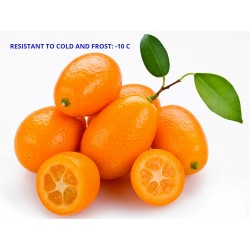
Kumquats or cumquats Seeds...
Price
€2.95
SKU: V 50
Seeds Gallery Com,
5/
5
<h2 class=""><strong>Kumquats or cumquats Seeds - exotic tropical fruit</strong></h2>
<h3><span style="color: #ff0000;"><strong>Price for Package of 5 seeds.</strong></span></h3>
<p><span style="font-size: 10pt;">Kumquats or cumquats are a group of small fruit-bearing trees in the flowering plant family Rutaceae, either forming the genus Fortunella, or placed within Citrus sensulato. The edible fruit closely resembles that of the orange (Citrus sinensis), but it is much smaller and ovular, being approximately the size and shape of an olive. The English name "kumquat" derives from the Cantonese pronunciation gam1 gwat1 (given in Jyutping romanization).</span></p>
<p><span style="font-size: 10pt;">They are slow-growing evergreen shrubs or short trees, from 2.5 to 4.5 meters (8 to 15 ft) tall, with dense branches, sometimes bearing small thorns. The leaves are dark glossy green, and the flowers white, similar to other citrus flowers, borne singly or clustered in the leaf-axils. Depending on size, the kumquat tree can produce hundreds or even thousands of fruits each year.[1] The tree can be hydrophytic, with the fruit often found floating on water near shore during the ripe season.[citation needed]</span></p>
<div><span style="font-size: 10pt;">The plant is native to south Asia and the Asia-Pacific region. The earliest historical reference to kumquats appears in literature of China in the 12th century. They have long been cultivated in Japan, Taiwan, the Philippines, and southeast Asia. They were introduced to Europe in 1846 by Robert Fortune, collector for the London Horticultural Society, and shortly thereafter into North America.</span></div>
<div><span style="font-size: 10pt;">Classification</span></div>
<div><span style="font-size: 10pt;">Carl Peter Thunberg originally classified the kumquats as Citrus japonica in his 1784 book Flora Japonica. In 1915, Walter T. Swingle reclassified them in a segregate genus, Fortunella, named in honor of Robert Fortune. Seven species of Fortunella have generally been recognized—F. japonica, F. margarita, F. crassifolia, F. hindsii, F. obovataand F. polyandra, as well as the recently described F. bawangica . The Flora of China returns the kumquat to Citrus and combines the species into the single species as Citrus japonica.[2]</span></div>
<div><span style="font-size: 10pt;">Varieties :</span></div>
<div><span style="font-size: 10pt;">Round kumquat</span></div>
<div><span style="font-size: 10pt;">The round kumquat (also Marumi kumquat or Morgani kumquat) is an evergreen tree, producing edible golden-yellow colored fruit. The fruit is small and usually round but can be oval shaped. The peel has a sweet flavor but the fruit has a sour center. The fruit can be eaten cooked but is mainly used to make marmalade and jelly. It is grown as an ornamental plant and can be used in bonsai. This plant symbolizes good luck in China and other Asian countries, where it is sometimes given as a gift during the Lunar New Year. It's more commonly cultivated than most other kumquats as it is cold tolerant. It can be kept as a houseplant.</span></div>
<div><span style="font-size: 10pt;">When the kumquats are divided into multiple species the name Fortunella japonica (Citrus japonica) is retained by this group.</span></div>
<div><span style="font-size: 10pt;">Oval kumquat</span></div>
<div><span style="font-size: 10pt;">Fortunella margarita, also known as the oval kumquat or the Nagami kumquat, is a close relative to Citrus species. It is a small evergreen tree, that can reach more than 12 ft (4 m) high and 9 ft (3 m) large. It is native to southeastern Asia, and more precisely to China. The oval kumquat has very fragrant citrus-like white flowers, and small edible oval orange fruits. The oval kumquat is an ornamental little tree, with showy foliage, flowers and fruits. It is also fairly frost-hardy, and will withstand negative temperatures such as 14 °F (-10 °C), and even a little lower for very brief periods. It can be grown in USDA hardiness zones 9 and warmer, but can also be tried in sheltered places, in USDA hardiness zone 8. Unlike most citrus species, the oval kumquat has a shorter growth period, and goes into dormancy fairly earlier in autumn. This partly explains its better frost hardiness.</span></div>
<div><span style="font-size: 10pt;">Characteristics</span></div>
<div><span style="font-size: 10pt;">The evergreen leaves of oval kumquats are deep-green and relatively small. They can reach up to 3 in (7 cm) long and 1.5 in (3.5 cm) wide. The white flowers of the oval kumquat are similar to the citrus flowers. They are strongly perfumed, and they appear relatively late in the growing season, generally late spring.</span></div>
<div><span style="font-size: 10pt;">The oval kumquat is a fruit that looks like any citrus fruit, with an orange rind. The fruits are oblong, up to 2 in (5 cm) long. Unlike the common citrus, which have a rind which is inedible raw, oval kumquats have an edible sweet rind. The flesh, however, is not as sweet as the rind, and the juice is quite acidic and sour, with a lemon-like flavor. This fruit is generally eaten fresh, with its rind. It can also be processed into preserves, jams, and other products.</span></div>
<div><span style="font-size: 10pt;">Cultivation</span></div>
<div><span style="font-size: 10pt;">The oval kumquat needs a well-drained and fertile ground. It dislikes alkaline soils. The oval kumquat is susceptible to common citrus pests and diseases.</span></div>
<div><span style="font-size: 10pt;">Jiangsu kumquat</span></div>
<div><span style="font-size: 10pt;">The Jiangsu kumquat or Fukushu kumquat bears edible fruit that can be eaten raw. The fruit can be made into jelly and marmalade. The fruit can be round or bell shaped; it is bright orange when fully ripe. It may also be distinguished from other kumquats by its round leaves that make this species unique within the genus. It is grown for its edible fruit and as an ornamental plant. It cannot withstand frost.</span></div>
<div><span style="font-size: 10pt;">When the kumquats are divided into multiple species the name Fortunella obovata (Citrus obovata) is used for this group.</span></div>
<div><span style="font-size: 10pt;">Cultivation and uses</span></div>
<div><span style="font-size: 10pt;">Kumquats are cultivated in China, South Korea, North Korea, Taiwan, Southeast Asia, Japan, the Middle East, Europe (notably Corfu, Greece), southern Pakistan, and the southern United States (notably Florida, Louisiana, Alabama) and California.</span></div>
<div><span style="font-size: 10pt;">They are much hardier than other citrus plants such as oranges. The 'Nagami' kumquat requires a hot summer, ranging from 25 °C to 38 °C (77 °F to 100 °F), but can withstand frost down to about −10 °C (14 °F) without injury. They grow in the tea hills of Hunan, China, where the climate is too cold for other citrus fruits, even the Mikan (also known as the Satsuma) orange. The trees differ also from other citrus species in that they enter into a period of winter dormancy so profound that they will remain in it through several weeks of subsequent warm weather without putting out new shoots or blossoms. Despite their ability to survive low temperatures, kumquat trees grow better and produce larger and sweeter fruits in warmer regions.</span></div>
<div><span style="font-size: 10pt;">Uses</span></div>
<div><span style="font-size: 10pt;">Kumquats are often eaten raw. As the rind is sweet and the juicy center is sour, the raw fruit is usually consumed either whole—to savor the contrast—or only the rind is eaten. The fruit is considered ripe when it reaches a yellowish-orange stage and has just shed the last tint of green.</span></div>
<div><span style="font-size: 10pt;">Culinary uses include candying and kumquat preserves, marmalade, and jelly. Kumquats can also be sliced and added to salads. In recent years kumquats have gained popularity as a garnish for cocktail beverages, including the martini as a replacement for the more familiar olive. A kumquat liqueur mixes the fruit with vodka or other clear spirit. Kumquats are also being used by chefs to create a niche for their desserts and are common in European countries.</span></div>
<div><span style="font-size: 10pt;">The Cantonese often preserve kumquats in salt or sugar. A batch of the fruit is buried in dry salt inside a glass jar. Over time, all the juice from the fruit is diffused into the salt. The fruit in the jar becomes shrunken, wrinkled, and dark brown in color, and the salt combines with the juice to become a dark brown brine. A few salted kumquats with a few teaspoons of the brine/juice may be mixed with hot water to make a remedy for sore throats.[citation needed] A jar of such preserved kumquats can last several years and still keep its flavor.[citation needed]</span></div>
<div><span style="font-size: 10pt;">In the Philippines and Taiwan, kumquats are a popular addition to green tea and black tea, either hot or iced.</span></div>
<div><span style="font-size: 10pt;">In Vietnam, kumquat bonsai trees (round kumquat plant) are used as a decoration for the Tết (Lunar New Year) holiday. Kumquat fruits are also boiled or dried to make a candied snack called mứt quất.</span></div>
<div>
<div>
<div>
<table cellspacing="0" cellpadding="0" border="1">
<tbody>
<tr>
<td colspan="2" width="100%" valign="top">
<p><span style="color: #008000; font-size: 10pt;"><strong>Sowing Instructions</strong></span></p>
</td>
</tr>
<tr>
<td valign="top" nowrap="nowrap">
<p><span style="color: #008000; font-size: 10pt;"><strong>Propagation:</strong></span></p>
</td>
<td valign="top">
<p><span style="color: #008000; font-size: 10pt;">Seeds</span></p>
</td>
</tr>
<tr>
<td valign="top" nowrap="nowrap">
<p><span style="color: #008000; font-size: 10pt;"><strong>Pretreat:</strong></span></p>
</td>
<td valign="top">
<p><span style="color: #008000; font-size: 10pt;">0</span></p>
</td>
</tr>
<tr>
<td valign="top" nowrap="nowrap">
<p><span style="color: #008000; font-size: 10pt;"><strong>Stratification:</strong></span></p>
</td>
<td valign="top">
<p><span style="color: #008000; font-size: 10pt;">0</span></p>
</td>
</tr>
<tr>
<td valign="top" nowrap="nowrap">
<p><span style="color: #008000; font-size: 10pt;"><strong>Sowing Time:</strong></span></p>
</td>
<td valign="top">
<p><span style="color: #008000; font-size: 10pt;"> all year round </span></p>
</td>
</tr>
<tr>
<td valign="top" nowrap="nowrap">
<p><span style="color: #008000; font-size: 10pt;"><strong>Sowing Depth:</strong></span></p>
</td>
<td valign="top">
<p><span style="color: #008000; font-size: 10pt;">0.5-1 cm</span></p>
</td>
</tr>
<tr>
<td valign="top" nowrap="nowrap">
<p><span style="color: #008000; font-size: 10pt;"><strong>Sowing Mix:</strong></span></p>
</td>
<td valign="top">
<p><span style="color: #008000; font-size: 10pt;">Coir or sowing mix + sand or perlite</span></p>
</td>
</tr>
<tr>
<td valign="top" nowrap="nowrap">
<p><span style="color: #008000; font-size: 10pt;"><strong>Germination temperature:</strong></span></p>
</td>
<td valign="top">
<p><span style="color: #008000; font-size: 10pt;">min. 20° C.</span></p>
</td>
</tr>
<tr>
<td valign="top" nowrap="nowrap">
<p><span style="color: #008000; font-size: 10pt;"><strong>Location:</strong></span></p>
</td>
<td valign="top">
<p><span style="color: #008000; font-size: 10pt;">bright + keep constantly moist not wet</span></p>
</td>
</tr>
<tr>
<td valign="top" nowrap="nowrap">
<p><span style="color: #008000; font-size: 10pt;"><strong>Germination Time:</strong></span></p>
</td>
<td valign="top">
<p><span style="color: #008000; font-size: 10pt;">Until it Germinates 7days - 2 Months</span></p>
</td>
</tr>
<tr>
<td valign="top" nowrap="nowrap">
<p><span style="color: #008000; font-size: 10pt;"><strong>Watering:</strong></span></p>
</td>
<td valign="top">
<p><span style="color: #008000; font-size: 10pt;">Water regularly during the growing season</span></p>
</td>
</tr>
<tr>
<td valign="top" nowrap="nowrap">
<p><span style="color: #008000; font-size: 10pt;"><strong> </strong></span></p>
</td>
<td valign="top">
<p><br><span style="color: #008000; font-size: 10pt;">Seeds Gallery 05.11.2012.</span></p>
</td>
</tr>
</tbody>
</table>
</div>
</div>
</div>
V 50 N


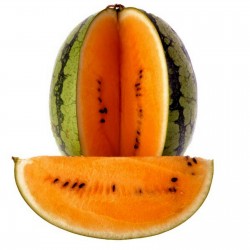
Orange Watermelon Seeds...
Price
€2.25
SKU: V 51
Seeds Gallery Com,
5/
5
<h2><strong>Orange Watermelon Seeds "Tendersweet"</strong></h2>
<h2><span style="color: #ff0000;"><strong>Price for Package of 10 seeds.</strong></span></h2>
<p>Watermelon Yellow Orange is an unusual and very attractive watermelon. This highly prized variety which has pure orange flesh inside not only tastes great, it looks fabulous as well, the perfect complement to the standard red-fleshed types such as Sugar Baby. The flesh which is very sweet sometimes gives the impression of being bland but this is only because of the colour</p>
<p>Watermelon Orange Flesh produces firm, good quality and evenly shaped fruit on a bushy plant</p>
<p>Heavy for their size the melons which can weigh anything from 3.5 - 5.5 kilos have a superb watermelon flavour and are highly rated. Can be cultivated outdoors but gives the best results in the British Isles when grown under protection.</p><script src="//cdn.public.n1ed.com/G3OMDFLT/widgets.js"></script>
V 51 (10 S)

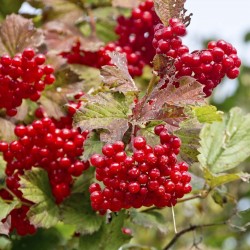
American cranberry bush...
Price
€2.45
SKU: V 52
Seeds Gallery Com,
5/
5
<!DOCTYPE html>
<html>
<head>
<meta http-equiv="Content-Type" content="text/html; charset=UTF-8" />
</head>
<body>
<h2><strong>American cranberry bush Seeds (Viburnum trilobum)</strong></h2>
<h2><span style="color: #ff0000;"><strong>Price for Package of 10 seeds.</strong></span></h2>
<p>Hardy, Adaptable, Easy to Grow, Showy Flowers, Fall Color, Showy Edible Fruits, Attracts Birds and Butterflies, Wildlife Food/Shelter, Hedge/Shrub Border, Bonsai, Cold, Heat, Drought and Wind Tolerant.</p>
<p>American Highbush Cranberry is not related to true cranberries; the name comes from its tart, edible red fruits.</p>
<p>The American Highbush Cranberry is native to swampy woods, bogs, lake margins, pastures, thickets, slopes, and moist low places from New Brunswick to British Columbia south to New York, the Great Lakes, South Dakota, and Oregon. It is a deciduous shrub with a rounded, upright spreading and sometimes arching habit. It typically grows to 10 to 15 feet tall. The leaves are three-lobed, maple-like, shiny dark green turning an attractive yellow red or reddish-purple in the fall. In spring it features an outer ring of 3/4 inch white sterile flowers surrounding the fertile but inconspicuous inner flowers, in a 3-inch flat-topped cluster. The flowers are followed by drooping clusters of cranberry-like bright red 1/4 inch edible berries (drupes) in the fall. The berries are edible fresh off the shrub and are much less bitter than those berries found on Viburnum opulus.</p>
<p>The berries are sometimes used to make jams and jellies.</p>
<p><b><span>Zone:</span></b><span> 3 to 8</span></p>
<p><b><span>Growth Rate:</span></b><span> Medium</span></p>
<p><b><span>Plant Type:</span></b><span> Deciduous Fruiting Shrub</span></p>
<p><b><span>Family:</span></b><span> </span><span lang="EN">Adoxaceae</span></p>
<p><b><span>Native Range:</span></b><span> Northern North America<br /><b>Height:</b> 8 to 15 feet<br /><b>Spread:</b> 10 to 15 feet<br /><b>Shape:</b> Rounded with upright-spreading to irregular and arching branching.</span></p>
<p><b><span>Bloom Time:</span></b><span> </span><span>April - May</span></p>
<p><b><span>Bloom Color:</span></b><span> </span><span>White<br /><b>Flower/Fruit:</b> Small white flowers held in flat clusters followed by bright red 1/4 inch edible berries.</span></p>
<p><b><span>Sun:</span></b><span> </span><span>Full sun to part shade</span></p>
<p><b><span>Fall Color:</span></b><span> Yellow red or reddish-purple</span></p>
<p><b><span>Drought Tolerance:</span></b><span> Moderate to High</span></p>
<p><b><span>Water:</span></b><span> </span><span>Medium to wet<br /><b>Maintenance:</b> Low</span></p>
<p><a name="lbl_culture"></a><b><span>Site Requirements/</span></b><span><b> Soil Tolerances</b></span><span>: Easily grown in average, medium moisture, well-drained soil in full sun to part shade. Prefers loams with consistent moisture, but tolerates a wide range of soils. Sometimes grows in wet or boggy soils in its native habitat.</span></p>
<p><span><b>Culture:</b></span><span> Very tough and easy to grow. Occasional pruning to remove oldest stems may be helpful.</span></p>
<p><b><span>Uses</span></b><span> Shrub borders or foundations. Woodland margins. Hedge or screen.</span></p>
<h3><b><span>Sowing </span></b><b><span lang="EN">Viburnum trilobum<span> </span></span></b><b><span>Seeds:</span></b></h3>
<p><span lang="EN">American Highbush Cranberry</span><span> seed </span><span>needs a warm spell then a cold spell in order to mature the embryo and reduce the seed coat.</span></p>
<p><span>For best results, please follow the instructions in the order provided.</span></p>
<p><strong><span>Scarify:</span></strong><strong><span> Soak </span></strong><span>24 hours</span></p>
<p><strong><span>Stratify</span></strong><strong><span> </span></strong><span>Warm 90 Days,<strong> then Cold 60 days, 40 Degrees F in a Moist Medium.</strong></span></p>
<p><strong><span>Germination:</span></strong><strong><span> Sow 1/4” deep</span></strong></p>
<p><span>For more information about seed pretreatment and growing trees and shrubs from seed, please download this .pdf:</span></p>
<p><strong><a href="https://www.forestresearch.gov.uk/documents/1449/fcpg018.pdf " target="_blank" rel="noopener">https://www.forestresearch.gov.uk/documents/1449/fcpg018.pdf </a></strong></p>
</body>
</html>
V 52 (10 S)






